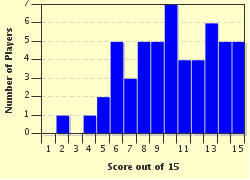Quiz Answer Key and Fun Facts
1. This aircraft is a Sopwith 7F.1 Snipe, which entered service with the RAF late in 1918. The Snipe succeeded which famous Sopwith fighter that had been introduced in 1917?
2. Another aircraft inherited by the fledgling RAF was the Airco DH.9A. This aircraft was designed by which person, who set up his own aircraft company out of Airco's assets after World War One?
3. During the period between the First and Second World Wars, the RAF underwent many changes, including being used for policing parts of the world under British control. One of the types used was this aircraft designed by Bristol. What is this aircraft known as?
4. This aircraft is a Hawker Hart light bomber. There were a number of variants of the Hart built that were named Audax, Demon, Hind, Osprey and Hardy. True or False?
5. This next aircraft is a Stranraer flying boat. It was built by which aircraft company, entering service a few years prior to the start of World War II?
6. The aircraft under restoration in this image gained the nicknames of the "Wooden Wonder" and the "Timber Terror", what is the name of this aircraft?
7. The aircraft in this image is a Hawker Hurricane designed by Sidney Camm. Hawker Hurricanes shot down more German aircraft during the Battle of Britain than the Supermarine Spitfire. True or False?
8. Designed by Bristol, this aircraft was nicknamed the "Whistling Death" by the Japanese when it was used against them during World War Two. What is this the name of this aircraft?
9. As World War Two progressed, the RAF introduced larger bombers capable of carrying heavy bomb loads, what is the name of this famous four engine heavy bomber depicted?
10. As World War Two drew to end, the RAF entered the jet age with its first operational jet fighter. What is this the name of this fighter?
11. This next aircraft is an English Electric Canberra designed to replace the de Havilland Mosquito. In which year as the last Canberra finally retired from RAF service?
12. This aircraft is the English Electric Lightning, the only British built jet fighter capable of obtaining Mach 2 to see operational service with the RAF: True or False?
13. The Panavia Tornado was built-in collaboration with a number of European countries. Which of the following countries DID NOT contribute to the development of the Tornado?
14. The Hawker Siddeley Harrier is known the world over for its capability to take off and land vertically. After which bird-of-prey was the prototype - the Hawker P.1127 - named before it became known as the Harrier?
15. In this image are two aircraft that form the future of the RAF. One is the F.35 Lightning II, the other - suspended above the F.35 - is the Eurofighter which shares it name with which famous RAF fighter-bomber of World War Two?
Source: Author
mcsurfie
This quiz was reviewed by FunTrivia editor
stedman before going online.
Any errors found in FunTrivia content are routinely corrected through our feedback system.
